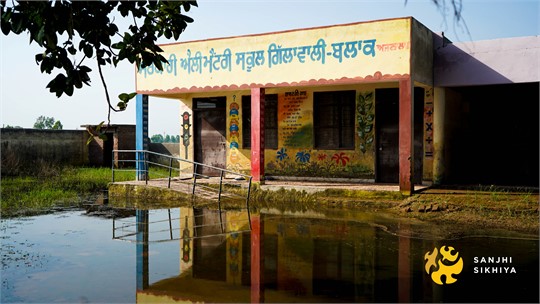Empowering Youth to restore safe and joyful spaces for every child
Over 20 lakh people in 2,200+ villages lost their homes, schools, farmland, and safety due to the September 2025 floods in Punjab. In addition to the immediate damage, it deeply wounded the hearts of children, especially those studying in government schools, the backbone of Punjab’s public education system.
Consider Manjit, a six-year-old Amritsar boy. His family spent two days cooking on a repurposed stove while witnessing the endless water surrounding them as the floodwaters rose. His classroom was unsafe and damp, and he had lost his school bag. His mother works tirelessly to support the family with the help of relief materials while his father struggles to find employment. He smiled despite being barefoot and having an untreated fungal infection on his leg.
However, beneath that smile lay a child deprived of routine, hope, and security. Manjit and thousands of other kids now bear this invisible weight.
Why Relief Alone is Not Enough
People received blankets, medications, and food packets as relief. However, the more difficult-to-see damage emerged as the water subsided:
- Disrupted education: 3,300 schools are unsafe to learn in, and the risk of dropping out is increasing.
- Families are weakened: Children become more vulnerable as livelihoods are destroyed.
- Unseen children: neglected psychological trauma.
- Villages and panchayats were overburdened and lacked systemic readiness, leaving communities worn out.
Floods are a turning point, not just an incident. The future of Punjab's children will depend on how it reacts.
Our Approach: Youth Leadership + Collective Action → Schools of Strength
The resilience and commitment of Punjab’s youth are its greatest resource. Sanjhi Sikhiya has been channelling this potential for nearly ten years through the Punjab Youth Leaders Program (PYLP), in which newly graduated students live and work in rural areas to support government schools, empower Panchayats, and inspire communities.
- 65% of PYLP graduates continue to work in Punjab’s social development sector even after their fellowship, strengthening long-term systems.
- Impact Evidence: PYLP-driven interventions demonstrated a measurable difference between baseline and midline assessments in 237 schools spread across 4 districts:
- Stimulating School Environment: 26.9% improvement
- Safety & Hygiene: 21.5% improvement
- Physical Development & Play: 12.7% improvement
These results reveal how systemic resilience is fuelled by youth-led action when it is integrated into schools.
Now, after the floods, we are scaling this model to heal 100 schools in Amritsar, with a five-year commitment to building climate-resilient schools where children can feel safe, supported, and hopeful again.
Schools of Strength: A 15-Point Pathway
Relief → Recover → Rehab → Transform
Led by 20 Youth Leaders in 100 schools of Amritsar.
Relief
1. To ensure that learning continues, relocate kids from unsafe classrooms to nearby safe areas.
2. Schools are to be cleaned and disinfected, trash removed, restrooms and handwashing stations restored.
3. Restart midday meals in safe kitchens to ensure children eat hot, nutritious food every day.
4. Give each child a dignity kit that includes basic supplies, books, and uniforms.
Recover
5. Set up safe corners with books, stationery, and first-aid in waterproof storage.
6.Conduct remedial and catch-up classes to help students make up for what they have missed.
7. Use games, art, storytelling, and group sharing to create healing spaces.
8. Hold workshops on resilience, stress management, and mindfulness for parents, teachers, and students.
Rehab
9. Provide teacher workshops to improve pedagogy and reduce stress.
10. Establish student clubs to promote peer support, hygiene drives, and climate awareness.
11. Educate families and students on safety drills, evacuation routes, and flood signs.
12. Start youth-led campaigns to raise awareness of climate anxiety and mental health.
Transform
13. Monitor school attendance, safety, and cleanliness on a monthly basis; report results at Panchayat meetings.
14. Create youth-led School Climate Resilience Committees in collaboration with Panchayats and local administrations.
15. Include lessons in classrooms daily about empathy, cooperation, and climate responsibility.
Why This Matters
It is a five-year commitment to systemic rebuilding using collective action and youth leadership. We will safeguard the present and future of thousands of children by concentrating on 100 climate-resilient government schools and creating replicable models throughout Punjab.
- Timeframe: 5 years of consistent engagement.
- Scale: 100 schools in Amritsar, designed for replication statewide.
- Outcome: A generation of children who become resilient, self-assured adults in addition to surviving calamities.
How You Can Help
Punjab has risen before; after Partition, migration, and violence. Every time, it was the collective spirit that rebuilt us.
Your support can power Youth Leaders to heal schools and bring back joy for children like Manjit. Join us in this seva
$100 — Restore Learning Spaces
Help relocate children into safe classrooms and provide basic dignity kits.
$150 — Create Healing & Growth Corners
Fund art, play, and storytelling corners across 5 schools for children to regain confidence.
$250 — Power a Youth Leader for a Month
Support a Youth Leader to mobilise communities, rebuild schools, and prepare them for future climate challenges.
You can also choose to donate on a monthly basis to our five-year commitment in Amritsar, customising your amount and joining Punjab's children as they recover, grow, and learn. Stable hands are necessary for big change.
Together, We Can Heal Punjab
Let's work together to make sure that the next time Manjit smiles, it's not to cover up his pain but rather because he sees hope for the future.

